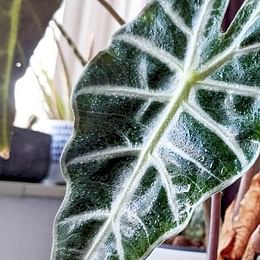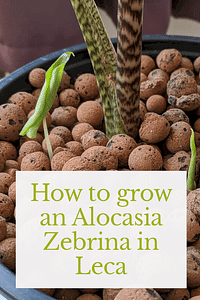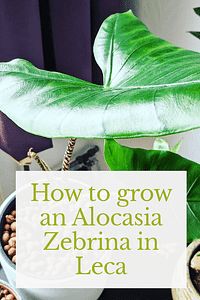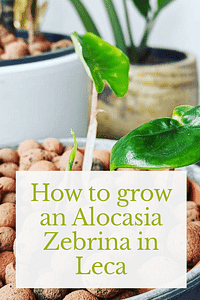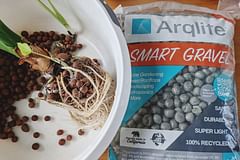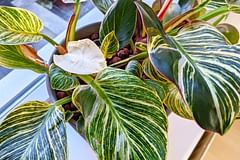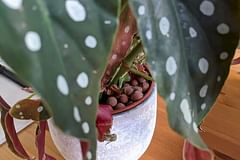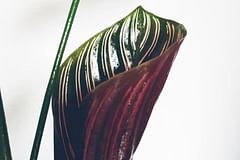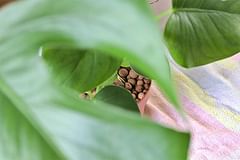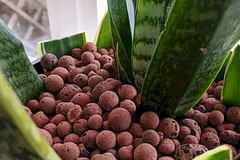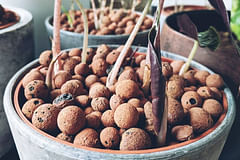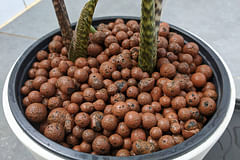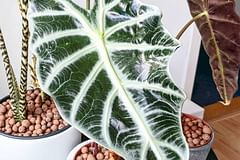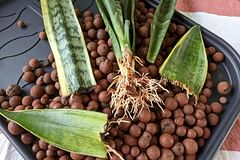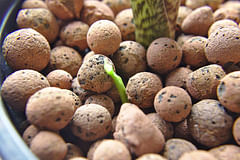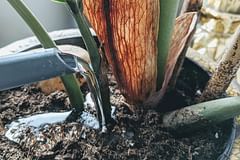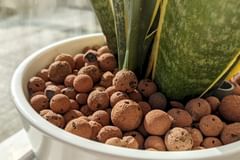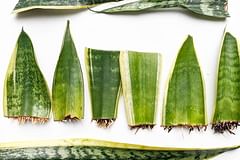How to grow an Alocasia Zebrina in Leca
Leca is a great way to properly water your plants, prevent pests, and fertilizing your plants consistently. In this guide, we go over the steps you have to take to properly take care of the Alocasia Zebrina when it's planted in Leca.
Last updated on:
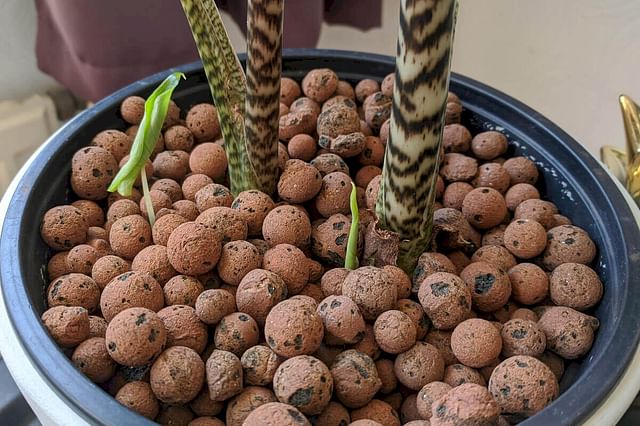 Watering a plant, dealing with pests, and fertilizing plants can be tough at times. When using soil there are a lot of different things you have to think about when taking care of plants. Did you get the right soil? Does this plant like to be in moist soil or should it be dry most of the time? These are all great questions to ask when you're working with different plants in soil.
Watering a plant, dealing with pests, and fertilizing plants can be tough at times. When using soil there are a lot of different things you have to think about when taking care of plants. Did you get the right soil? Does this plant like to be in moist soil or should it be dry most of the time? These are all great questions to ask when you're working with different plants in soil.
But taking care of plants doesn't have to be difficult all the time. There is a great way to stop worrying about the right soil, moisture levels, and pests: use Leca instead of soil. If you don't know what Leca is you can read the guide What is Leca and why is it useful for plants?.
In this guide, we're going over how to grow Alocasia Zebrinas (and all other Alocasias for that matter) in Leca. We'll go over converting your Alocasia from a soil-based plant to a Leca plant. Then we'll go over how to plant your plant in Leca and water it. This all might sound intimidating, but it's easier than you think. This guide will take you through the whole process.
These are the topics we're going to look at:
Let's get started!
Process & Required materials
When you want to grow your plants in Leca, there are a few things you'll need to get. These are the materials you need to follow along with this guide:
- Leca
- A plastic nursery pot with holes in the bottom
- A waterproof pot that can hold the nursery pot
- An Alocasia Zebrina (or any other Alocasia)
- Hydroponics fertilizer (do not use fertilizer meant for plants in soil)
1. Converting your soil-based Alocasia to a Leca-based plant
Converting your Alocasia from a soil-based plant to a Leca-based plant might take a while. Luckily this is something you only have to do once and then you've converted the plant. Much of this process is like repotting and splitting an Alocasia Zebrina.
You need to carefully remove all the dirt from the roots of the plant. In case you're unsure of how to do this you can read specifically how to do this in How to repot an Alocasia Zebrina.
You can use whichever method you like, but the easiest way is to use your hands. Once you have removed most of the dirt from the roots and your plant looks like the plant in the image below then you can start to use water. With the water, you can carefully wash the dust and the smaller pieces of soil off the roots.
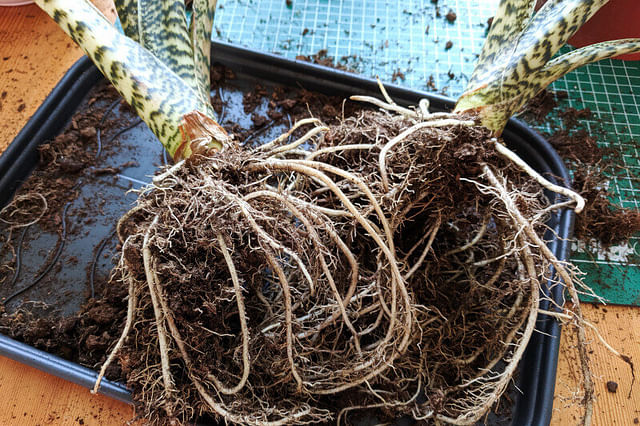 Alocasia Zebrina roots after most of the soil has been removed
Alocasia Zebrina roots after most of the soil has been removed
When you're going to use water to clean the roots further, make sure you don't use cold or hot water. Keep the water as close to room temperature as you can. The roots of the Alocasia Zebrina are very sensitive and drastic temperature changes could stress your plant out. This stress could kill your plant in the long run. You should wash the roots until it starts to resemble the roots of the Alocasia Zebrina in the picture below.
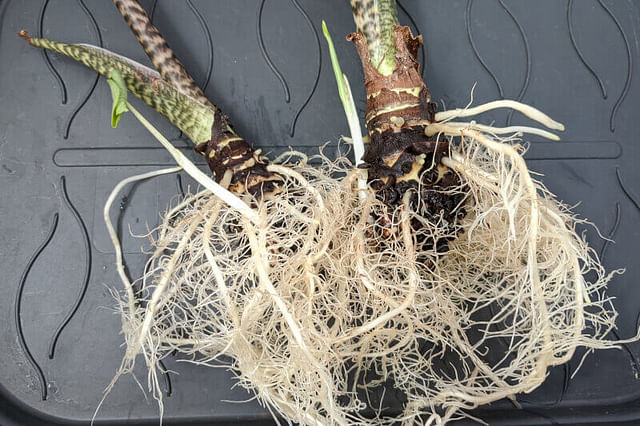 Alocasia Zebrina roots that have been grown in Leca
Alocasia Zebrina roots that have been grown in Leca
Your roots will most likely not look that white because the roots in the image above have been grown in Leca, so they have never touched soil. Your roots will be light brown, as the soil has stained the roots.
The most important part is that it is very little to no soil left on the roots. Any soil that's left on the roots is a potential source of root rot. If you only have a little bit of soil left, that's fine. You can wash this off during your next watering cycle and repeat this process until all soil is gone. This could take a few cycles, so don't feel bad if you can't get it clean right away. This is completely normal.
2. Preparing the pots for use with Leca
The next step in the process is to prepare your pots to be used with Leca instead of soil. Get the nursery pot and the waterproof pot that you chose at the beginning and wash them both thoroughly with water and soap. It's best to use a sponge for this because your hands won't be able to get in all though places.
When they're all clean, you can let them dry, but that's not a requirement. Below are the pots we'll use for the rest of the guide, with all soil cleaned out.
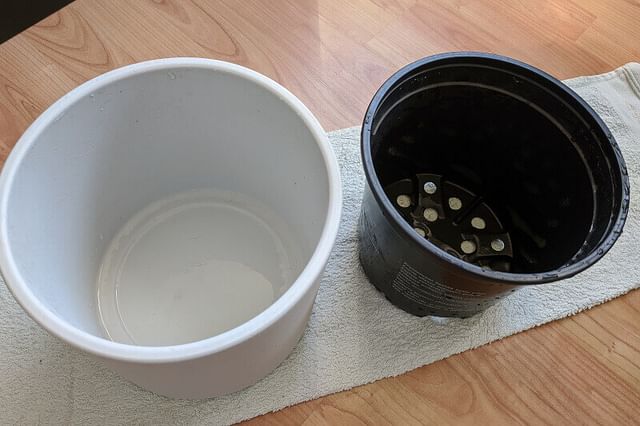 Washed nursery pot and waterproof pot
Washed nursery pot and waterproof pot
3. Preparing the Leca for use
Before we can plant the Alocasia Zebrina, we need to wash the Leca first. If you're using Leca that's already washed, you can skip to the next step. If you just bought a bag of Leca at a store, this step is very important.
When you buy a new bag of Leca at the store, there will be a lot of dust in the bag from the clay balls smashing against each other. You need to wash this dust off before you can use the Leca with plants.
To do this, get a bucket and get enough clay balls to fill your pot like in the first image of this post. Don't go all the way to the edge, because clay balls could roll out of the pot accidentally when handling your plant.
The bucket now has the Leca you need for this process. It's best to get an extra bucket to make the cleaning process much easier. First, fill the bucket with the Leca with water and wash the clay balls thoroughly. When they're clean, move them into the second bucket, leaving the dirty water in the bucket you used to clean the clay balls. Throw the dirty water away and repeat the process until the leftover water is (almost) clean. This could be 4-5 cycles. Afterward, you have clean Leca and you're ready to plant the Alocasia Zebrina in your pots and Leca.
4. Planting the Alocasia in the Leca
When your Leca is clean, you can add a little base layer of it into your nursery pot. The goal of this is to lift the roots of the Alocasia off the bottom of the pot. The roots can never sit in water because that could cause root rot. You're effectively creating a false bottom like in the picture below.
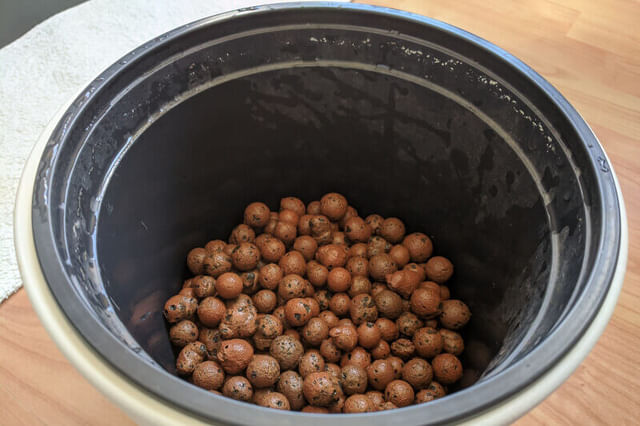 Leca as a base layer in the nursery pot
Leca as a base layer in the nursery pot
This false bottom will keep the water in the bottom away from the roots. At the same time, it makes sure that the Leca at the bottom can soak up the water in the waterproof pot and regulate it throughout the pot. When you've got a nice base of Leca in the pot, you can add the plants like in the image below.
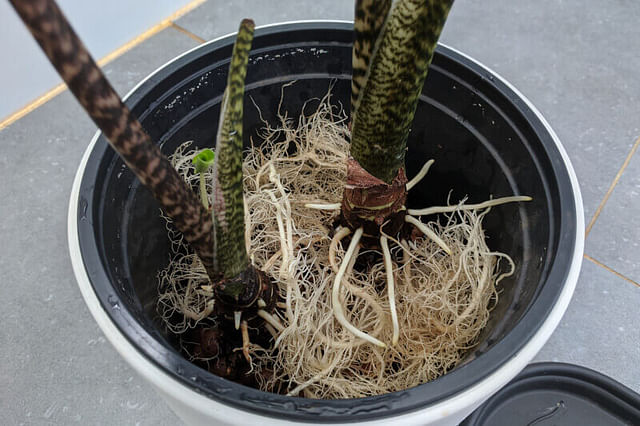 Alocasia Zebrina on to of Leca in the nursery pot
Alocasia Zebrina on to of Leca in the nursery pot
Now that you have the plants in the pot, you can carefully add Leca to the pot, covering the roots. At this stage you can still adjust the position of the plants in the pot, so place the plants to how you like the look best. This is all up to what you think looks great. You might have to hold the stems of the Alocasias with one hand and add the Leca with the other.
When you've added a small layer to secure the roots like in the image below, you can let go of the stem and use both hands to add Leca to the pot.
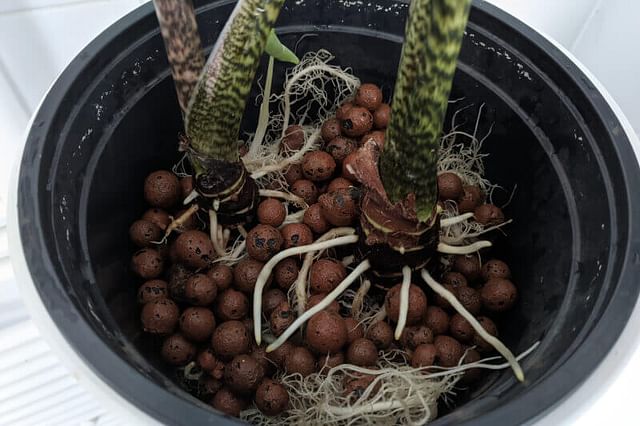 Alocasia Zebrina roots partially covered by Leca
Alocasia Zebrina roots partially covered by Leca
At this point, you can keep adding the Leca until you've filled the nursery pot up to the top. You might have some Leca left over. Keep this in a separate bag then the unwashed clay balls, otherwise, you'll have to wash these again next time you go through this process.
5. Watering the Alocasia in the Leca
Now that we've planted the Alocasia Zebrina in Leca, we're ready to water the plant for the first time. This is how you'll have to water your plant from now on. It's a bit different than watering plants in soil, but it's also much simpler to do and you won't risk overwatering your plant as easily.
To prepare the water, add the hydroponics fertilizer to it according to the instructions on the label of the fertilizer that you got.
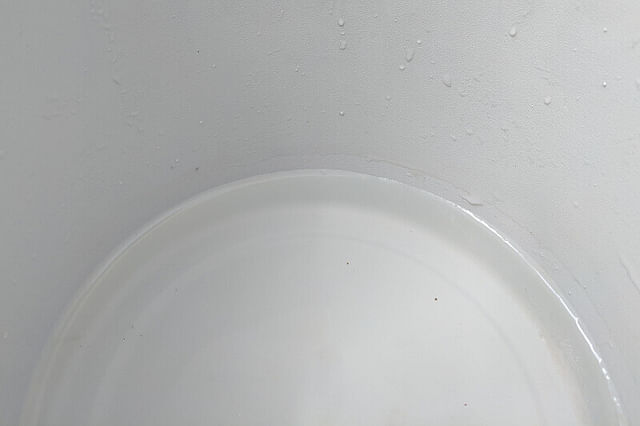 Water in the waterproof pot
Water in the waterproof pot
The only thing you have to keep in mind when adding water to the waterproof pot is to never let the roots of the Alocasia Zebrina sit in water. This is what we created the false bottom for with the Leca. This helps to keep the roots above the water level inside the waterproof pot. This could take some trial and error, so take your time to figure out how much water you need to add. If all else fails, you can also add less water so that only a small amount of Leca is sitting in the water. The Leca will spread and regulate the water for you. Add the water to the waterproof pot like in the image above.
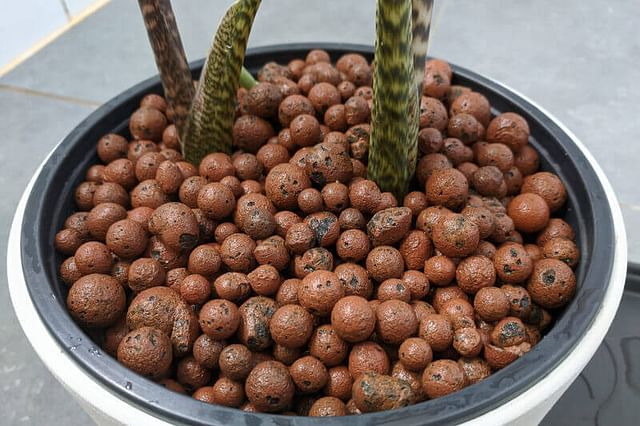 Plants in Leca after watering
Plants in Leca after watering
Afterward, you can put the nursery pot with the holes in the bottom back in the waterproof pot. The Leca will now start to soak up the water and regulate it throughout the pot. The plant will start to get the moisture and fertilizer it needs from the Leca.
If your Alocasia were to be more thirsty, it'll start to grow roots into the water at the bottom of the pot. This is how Leca makes sure to water your plants in moderation. If your plant isn't very thirsty, it'll gladly absorb the moisture from the clay balls and if it is thirstier, it'll get what it needs from the water sitting at the bottom of the pot.
6. Maintaining your Leca-based Alocasia Zebrina
You've taken your first steps into caring for a Leca-based Alocasia Zebrina, but it doesn't end here. Now that your plant is in loose clay balls, it's easy to take out of the pot to be able to check on the roots if you wanted.
In the first few weeks, you might have to take the plant out of the Leca every single week to clean the roots and the clay balls themselves. There might be more clay dust and leftover soil in the Leca. This is something you want to clean out as soon as you can.
After the first few weeks, when your Alocasia has started to grow new roots, you won't have to do this anymore. This is up to you. To check if your plant needs to be watered, all you need to do is check if the clay balls in the bottom are still sitting in the water or if they've soaked it all up.
If the clay balls have soaked up enough of the water so they're no longer sitting in the water at the bottom, it's time to refill with the water and fertilizer mixture. Don't worry about overwatering your plant, because this won't happen as long as the roots are not sitting in the water.
It's tough to say how often you should go through this watering process. This all depends on the size of your pot, the amount of Leca, and how thirsty your Alocasia is at that moment. For the plant and pot that's displayed in all these pictures, you can repeat the process every 2 weeks. Again, this might take a bit of trial and error on your part. If you want a good starting point, do this once per week and see if you need to do it this often.
Conclusion
Leca is a great way to properly water your plants, prevent pests, and fertilize your plants consistently. So why not try this with the beautiful but sometimes "tough to take care of" Alocasia Zebrina?
If you want to see this process in action (through photos), you can have a look at "How to plant an Alocasia Zebrina in Leca".
Thank you for reading this post! I hope it helps you to keep your plants healthy and beautiful! If you're looking for more guides on specific plants, you can always request a plant guide to get a guide for the plant you have trouble with.
Tags: hydroponics, leca
Posted on: May 10, 2020 Last updated on: Apr 21, 2023